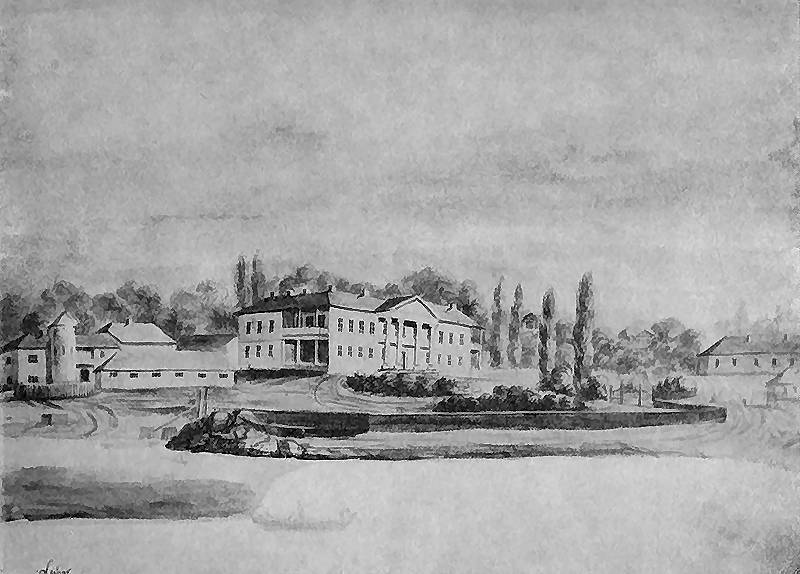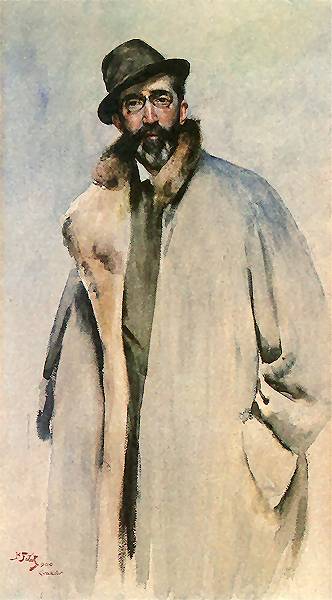An excerpt
from
Słownik Geograficzny (published 1884; page 375)
Translated
from Polish by Lawrence Krupnak, East Europe Connection; corrected and
augmented by Mariusz Wodzicki
LUBAR
- small town, county of Nowogród Wołyński, on Słucz River, in the most
fertile region of Wołyń, has 6,902 residents and 1,657 farmers who own
2,343 dziesięcinas of land.1
Established
between 1340 and 1382 by Prince Lubart Giedyminowicz, and for that
reason, for a long time, it was called Lubartów. Kochowski2 said about this
that "Lubarum seu Lubartovia, primo
conditori nomen debet a Lubarto conditum".3
Subsequently,
Lubar was included within the crown estates and given as a reward for
service to the princely House of Lubomirski; from them it passed to the
Walewski Family, and presently belongs to Countess Wodzicka née
Karwicka.4 Even today,
Lubar bears the signs of its past splendor. Post-Basilian walls of the
friars’ monastery and the church, which up to 1833 housed once famous
schools, second best in Wołyń after the Piarists of Międzyrzecze, today
converted into an Orthodox monastery. There remains only a tradition
and memories in the chronicles, for presently not even a trace remains
of that fortified castle founded in the XIV Century by Prince Lubart;
which, nevertheless, must have been fortified adequately to survive the
Cossack wars of the XVII Century and to withstand the siege of 1651;
whatever befell it later, nothing is known.
The greatest
attraction of Lubar even today is the parish church, initially of the
Dominican Friars, in a Romanesque style, founded by Prince Stanisław
Lubomirski in the XVIII century, rebuilt in stone and consecrated by
the Bishop of Kijów and
Chernichów, Załuski, in
1765, as the Church of Saint Michael and Saint Jan Nepomucen. In the
church is a picture of Christ, famous for miracles, brought to Lubar
from Hryniowce (county Zasławiec) in 1754 by Bishop Kajetan Sołtyk. It
appears that within this church or monastery there existed once a
greater picture gallery, because even today many more paintings can be
seen; there are many portraits of various bishops of Chełm, Płock,
Łuck; even Poznań, Kraków, Lwów; and from Lithuania; paintings of five
popes, many scenes from the Holy Bible and other, symbolic ones; a
group of seven pictures, depicting scenes of martyrdom inflicted by the
Tartars, particularly attracts attention. Remnants of an obviously once
splendid library favorably witness to the intellectual life of the
Dominican monks. A small palace of the owners of the estate, in an
Italian style, built next to the river on a high ground, ads
significant splendor to Lubar; similarly to be noted is one of the
larger houses in town, that at one time belonged to Countess Ponińska.
 Palace of the Counts Wodzicki in Lubar,
1862-1876.
Palace of the Counts Wodzicki in Lubar,
1862-1876.
A watercolour by Napoleon Orda (1807-1873), 20.5 × 27.7 cm, Muzeum Narodowe,
Kraków.
Today, Lubar
does not have any factories, except for the Łuczycki Organ and Music
Box Works, the Jakubowicz Carriage Workshop, an attractive flour mill
on the Słucz River, and a brewery; tradition has it, however, that at
one time there were here a cloth manufacture, a hat factory, a
wineshop, a book store, that survived until 1855, a printing shop run
by the church, public baths with showers and the famous spring waters
of the Basilian Friars, which, from the healing point of view,
adequately offered the Wołyń region an alternative to other fashionable
“spas,” and, during the bathing season, drew to Lubar large crowds of
visitors. This estate comprises 6,243 dziesięcinas of land, of which
5,675 dziesięcinas belong to the Count Wodzicki5
Family,
while other small owners control 568 dziesięcinas.
Lubar has a
police post and is the county seat, has a post office, a doctor and an
apothecary. Moreover, a peace judge and a peace mediator live here. The
Lubar Catholic parish of the Żytomierz Diocese has 2,172 souls, an
auxiliary church in Wolica Wielka (previously also in Nowa Czartoryja),
chapels in Pedyńki, Motowidłówka, Wyszczykusy (previously also in
Wygnanka and Seweryny). In 1870, Lubar had 4,922 residents, of whom 54
per cent were Israelites, 893 houses, 8 Orthodox churches, an Eastern
Orthodox convent, a church, a synagogue, 6 houses of prayer, 3
tanneries, a brewery, 116 stores, 90 artisans and three trade fairs.
See the article about Lubar by Komaszko in the “Vohlynian Province
News” 1862.
L.
R.
Translator's
Footnotes
1 pronounced
“dje-shen-chi-nah” - a Polish measure of area; there were two units in
use on the territory of Russian partition of Poland, both called
dziesięcina: dziesięcina
skarbowa (fiscal), equal
1.0925 hectare = 2.7 acres, and
dziesięcina duża (great), equal
1.4567
hectare
= 3.6 acres. Without
consulting the Dictionary itself it is difficult to say which one is
meant here.
2 a writer
and historian of the 17th Century.
3 a passage
in Latin which means “whether Lubar or Lubartów, it owes its name to
the name of its first founder, Lubart”.
4 Celestyna Franciszka Anna countess
Wodzicka, born 1835 in Mizocz, daughter of Kazimierz Krzysztof Jan count
Dunin-Karwicki z Karwic h. Łabędź
(1796-1852), and Klementyna
countess Rzyszczewska h. Pobóg (1812-1850) [h. = herbu which
means: of the coat of arms].
Her maternal grandmother was Celestyna
Anna Alina princess Czartoryska on Korzec & Oleksińce
(1790-1850).
On 27
Septemeber 1866 she married Alfred
count Wodzicki h. Leliwa on Złota,
Wawrowice, Morawica & Pełczyk (b.
1839).
Their
daughter, Anna (b. 20 July 1867), on 30 April 1889
married in Kraków Antoni
count Wodzicki on Niedźwiedź, Konina, Lubomierz, Łętowa, Łostówka,
Mszana Górna & Podobin (b. 5 Feb 1862). Her
husband was portrayed by leading Polish painters of the time
 Antoni
Wodzicki, 1900. A watercolour by
Stanisław Fałat (1853-1929), 99 × 44 cm, Muzeum Narodowe, Kraków
Antoni
Wodzicki, 1900. A watercolour by
Stanisław Fałat (1853-1929), 99 × 44 cm, Muzeum Narodowe, Kraków
 Antoni
Wodzicki, 1911. By Jacek
Malczewski (1854-1929), oil on canvas, 80 × 60 cm, Muzeum Narodowe,
Kraków
Antoni
Wodzicki, 1911. By Jacek
Malczewski (1854-1929), oil on canvas, 80 × 60 cm, Muzeum Narodowe,
Kraków
Antoni's father
was famous ornithologist, Kazimierz
Wodzicki (1816-1889).
5 Alfred
Wodzicki (mentioned in pevious footnote).



